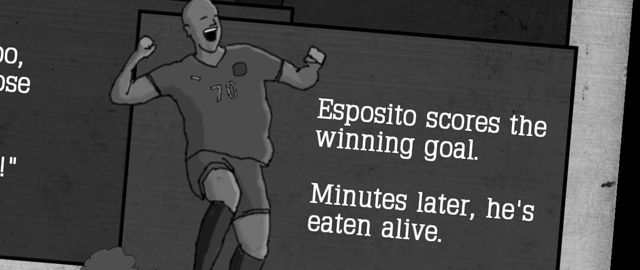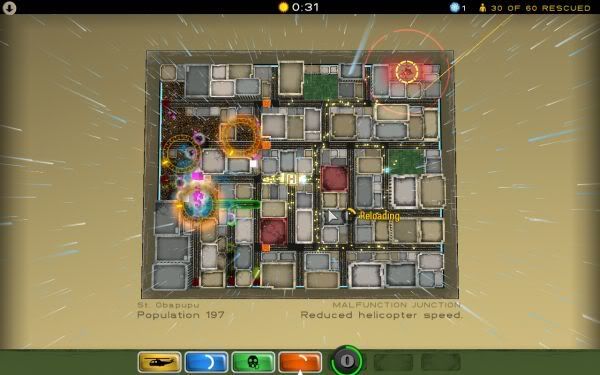This post has not been edited by the GamesBeat staff. Opinions by GamesBeat community writers do not necessarily reflect those of the staff.
Ben and Harry just can’t see eye to eye. Ever the resourceful hero, Ben wants to stay upstairs, where he can see out of the house’s boarded windows and doors. If things get ugly, he knows he can escape. Harry, a family man whose wife and wounded daughter wait below, believes this to be madness. “You’re insane! The cellar’s the safest place!” he cries. “The cellar’s a deathtrap,” retorts Ben.

Atom Zombie Smasher's opening vignette sets the game's dark-humor tone.
This scene from George Romero’s 1968 film Night of the Living Dead embodies the qualities of an engaging narrative. The external threat, zombies, is not the focal point here; rather, the clash between Ben and Harry demands our attention. Should the group retreat to the relative safety of the basement but risk becoming trapped, or should they leave their options open by staying on the first floor? Not only is this intragroup conflict interesting, but it mimics the type of choice that strategy gamers contend with every match.
Blendo Games’ Atom Zombie Smasher and Headup Games’ Trapped Dead (available on PC) both allow tactical decisions (i.e., gameplay) to shape narrative. Atom Zombie Smasher charges the player with commanding a withered military to rescue groups of people and hold back the tide of reanimated corpses while Trapped Dead offers a series of open-ended missions bound together with a regrettably forgettable story. Where one succeeds, the other stumbles.
Like those who took shelter in a Pennsylvanian farmhouse, the larger situation in Atom Zombie Smasher is outside of your control. You’ll never know ahead of time which units (infantry, snipers, artillery, landmines, remote-detonated explosives, and barricades) will be available for each in-game day. Thus, each extraction attempt forces you to make difficult decisions with limited resources about who to rescue and sacrifice.

Trapped Dead evokes an encroaching death well during the tactical portion of the game.
Games critic Tom Chick observed that these decisions elicit “moments of drama.” You’ll sigh with despair when you hear a chorus of muffled groans erupt from your speakers because a lone purple dot, which represents the undead, makes contact with a tightly packed group of yellow dots, survivors, waiting below a slowly descending rescue helicopter. You had diverted your infantry away from guarding the landing zone toward a large cadre of approaching corpses. Should you have risked shelling that street with artillery fire instead?
Trapped Dead takes you from Atom Zombie Smasher’s bird’s-eye view and brings you down to the street level. Rather than direct soldiers to save the lives of a city’s residents, you instead lead a small team of civilians across zombie-plagued concrete jungle.
The primary decision players must contend with is how to maneuver their parties through the undead-infested locales. Hand-to-hand combat is silent, but you risk becoming overwhelmed. Firearms are safer, but they attract attention. The longer path could result in fewer confrontations, but you may end up cornered. By contrast, the shorter route is likely much more dangerous.

Although abstracted, you'll care more about survivors in Atom Zombie Smasher.
Further choice comes from conversation between characters in a bunker that you’ll visit before and after every mission. You’ll decide whether to put your team in further jeopardy for long-term benefits (by searching for additional survivors and supplies) or pursue a faster escape from the recently reanimated.
In both games, player-initiated narrative derives directly from gameplay; unfortunately, Trapped Dead falters by adhering to uncreative and archaic states of failure. When a team member dies, you get a dreaded game-over screen. That adrenaline rush through rotting corpses where your party narrowly evaded certain death? Erased, and you're sent back to a save location. Yes, save locations. Like Final Fantasy.
Atom Zombie Smasher allows you to concede districts where the horde overran your operations (and really, anyone not playing in Permadeath mode is clearly doing it wrong). Whatever happened becomes a part of the permanent record — and I do mean that literally, as you're allowed to export a text file describing major events at the game's conclusion. Even with Atom Zombie Smasher's oddball vignettes, the narrative primarily comes from your tactical decisions in the field.

If anyone dies, you'll have to play through this sequence again and again….
And that's the glaring difference between both titles: Atom Zombie Smasher uses the medium's unique attribute, interactivity, to shape the story. Trapped Dead instead revels in stilted dialogue and cliché plot devices. (A virus caused the zombie outbreak? You don’t say.)
When Ben's and Tom's plan to refuel the truck goes awry (which results in both Tom's and Judy's deaths), Night of the Living Dead keeps going. Could you imagine the film suddenly coming to a stop, rewinding 15 minutes or so, and then projecting a slightly different sequence of scenes that concludes with a positive outcome? Strange, right? But that's exactly the type of story-breaking bullshit we put up with in video games.
Trapped Dead clearly wants to tell a tale — Headup has implemented a narrative-driven mission structure a lot like Fallout Tactics did 10 years ago. But the game is too focused on expressing its story rather than letting you write your own. Since this is a strategy game, I'm doubly disappointed, as this is one of the easier genres to embrace gameplay as a storytelling device. Just ask Atom Zombie Smasher.
